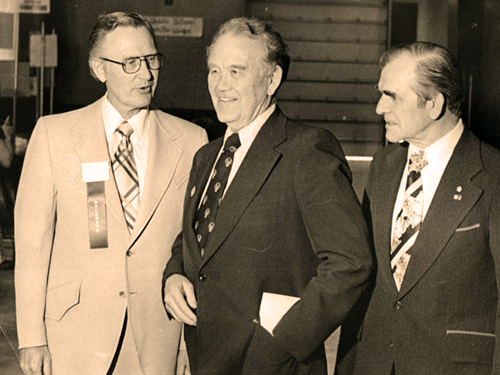1906 Through 1915
The nine years between 1906 and 1915 were marked by a series of revolutionary progressive successes, starting with John Burke’s election as governor in 1906. Alexander McKenzie’s conservative political machine controlled the Senate, but the House of Representatives was filled with progressive Democrats and Republicans, who managed to introduce many anti-railroad bills against the staunch opposition of lobbyists. Many pieces of progressive legislation and reforms were passed during this time, including a direct primary law, a joint resolution for a constitutional amendment for initiative and referendum power, a public library commission law, and laws to enforce prohibition. Subsequent years would see the end of Alexander McKenzie and his Republican political machine. By 1908, the first state electoral primaries solidified his retirement. That year the Republican Party, free from McKenzie’s conservative influence, crafted an extremely progressive party platform. Progressive Democratic Governor John Burke remained in position with Republican votes.
North Dakota again proved its progressive sympathies in 1912, when the state held the first United States Presidential Preference Primary on March 19. North Dakota Republicans favored progressive presidential candidate Robert M. La Follette over Theodore Roosevelt and William Howard Taft. Though an angry Roosevelt formed the Progressive Party after losing the nomination to Taft, he had little support from North Dakota, where many Progressives distrusted his backers, George Walbridge Perkins of the J.P. Morgan group and International Harvester. Because of this opposition, Woodrow Wilson carried the state in November. Republican Louis B. Hanna was elected governor in 1912 and 1914. Once in office, he and his legislative allies halted the creation of a state-operated grain elevator, which may have convinced progressives to unite in 1915.
1915
When Arthur C. Townley came to Bismarck, North Dakota in 1915, he saw strife between a conservative legislature and farmers’ interest groups. He knew that with the recent strife in Bismarck between a conservative legislature and the American Society of Equity and its farm following, the time was ripe for a political revolution. Townley resolved to organize the farmers, so that they could control the primaries, whether it be Republicans or Democrats or both. This was the organization of the Farmers Nonpartisan League (later called the National Nonpartisan League). Townley organized the farmers of the state together for united action in nominating at the primaries and electing at the polls the men of their own choosing and men who would carry out their programs.
The Method of Organization was simple, scientific, and successful. Organizers carefully went forth in ever increasing numbers to sell the idea to the farmers and to get their support for the new movement. The league grew in leaps and bounds. The first members were pledged in February 1915. Before midsummer, there were 10,000 members, and before winter set-in, there were 26,000 names enrolled.
The Nonpartisan League membership pledge was $2.50 a year, it later rose to nine dollars a year. The goal of the League was to use their collective best efforts to secure the nomination and election of men for office within the state; men whom the investigations of the League would have shown through their conviction, record, and conduct would approve and support legislation necessary for the purpose of saving millions of dollars each year for the farmer and would be nominated and elected to carry out the League program.
The League Program was concise and to the point. It consisted of five planks, as follows:
- State-owned and -operated elevators, flour mills, and packing plants
- State hail insurance
- Exemption of farm improvements from taxation
- Fair grain grades, based upon milling and baking values
- Rural credits at cost
Each was designed to remedy what the farmers conceived as an abuse, and each was to lower the cost of producing and marketing grain.
The determination of the League fulfilled their pledge and many of their planks passed legislation. The growth of far left sympathies was on the rise in North Dakota. The Socialists had considerable success. They brought in many outside speakers; Eugene V. Debs spoke at a large antiwar rally at Garrison in 1915. By 1912, there were 175 Socialist locals in the state. Rugby and Hillsboro elected Socialist mayors. The party had even established a weekly paper, the Iconoclast, in Minot, North Dakota.
Throughout the decades, the League pushed for the establishment of state-operated mills, elevators, and banks. While the state was not entirely isolationist, it was also neither entirely liberal nor entirely conservative. By 1952, the Nonpartisan League was itself divided.
1952
Two factions divided the traditionally liberal Nonpartisan League: on one side the insurgents on the other the old guard. Those that called themselves insurgents aligned liberally with the pro-farmers union, pro-organized labor, and pro-Democratic party groups. The insurgents wanted to take the League into the Democratic Party. In 1952, the insurgents formed the Volunteers for Stevenson Committee, to help elect then Democratic Candidate Adlai Stevenson. To the contrary the members of the old guard, also known as the Capitol Crowd, were the more conservative, anti-farmers’ union, antilabor, and pro-Republican segment of the League. These members wanted to keep the Nonpartisan League in the Republican Party; they supported Dwight D. Eisenhower in the 1952 presidential race.
Over the next four years legislative polarization grew, and the Nonpartisan League party eventually split in two. In 1956, North Dakota was fundamentally realigned into a two party system. That year, the Nonpartisan League finally moved into the Democratic Party, and all Republicans joined in one organization. Two statewide parties vied for the votes of North Dakota citizens. Creation of the Democratic Nonpartisan League Party was codified in March during the League Convention; 173 to 3 voted yes to file candidates in the Democratic column. The new party introduced a full slate of candidates for state office and adopted a liberal platform that included the repeal of the Taft–Hartley Act, creation of a minimum $1.25 an hour wage, and a graduated land tax on property worth $20,000 or more. Two months later, in May 1956, the Democratic Convention accepted the Nonpartisan League’s candidates and adopted its platform. Republicans in North Dakota also united after conservative supports broke away from the league.
Although the Democratic Party was still the minority, the number of Democrats in the state legislature increased greatly. Before the League moved into the Democratic Party, there were only five Democrats among the 162 members of both houses of the legislature in 1955. In 1957 the number grew to 28. In 1959, the numbers continued to grow, reaching 67 despite a drop to 62 members. In 1961, nevertheless, for the first time in history, North Dakota was becoming a two-party state.
Today
Economists are both impressed and speculative of the reasons for the state’s resiliencies toward the recent economic hardships most governments and citizens are experiencing. The Nonpartisan League laid a foundation of enriched public ownership and responsibility in such institutions as a State Bank. One study has concluded that it is these publicly operated institutions such as the State Bank that have helped North Dakota Citizens weather the economic storms of today.
The Bank of North Dakota was created to address market failures associated with monopoly power among large financial and business institutions in the early twentieth century. This market power meant that small farming operations had inadequate access to credit. One of the goals of the league was to remedy limited access to credit by establishing this institution. This policy would serve as a measure of the public good that still stands today and that some point to as playing a role in lessening the impact of economic recession. This public-private relationship helped to establish roles for each sector based on what they do best. It provided a balance of equity for the public and private banks and served as a safety net for North Dakota’s citizens. Praise rolled in for the early roots of the Democratic-Nonpartisan League party as they established this foundation that worked to balance the state in a time of national crisis and secured the agrarian futures of farming families for generations to come.


